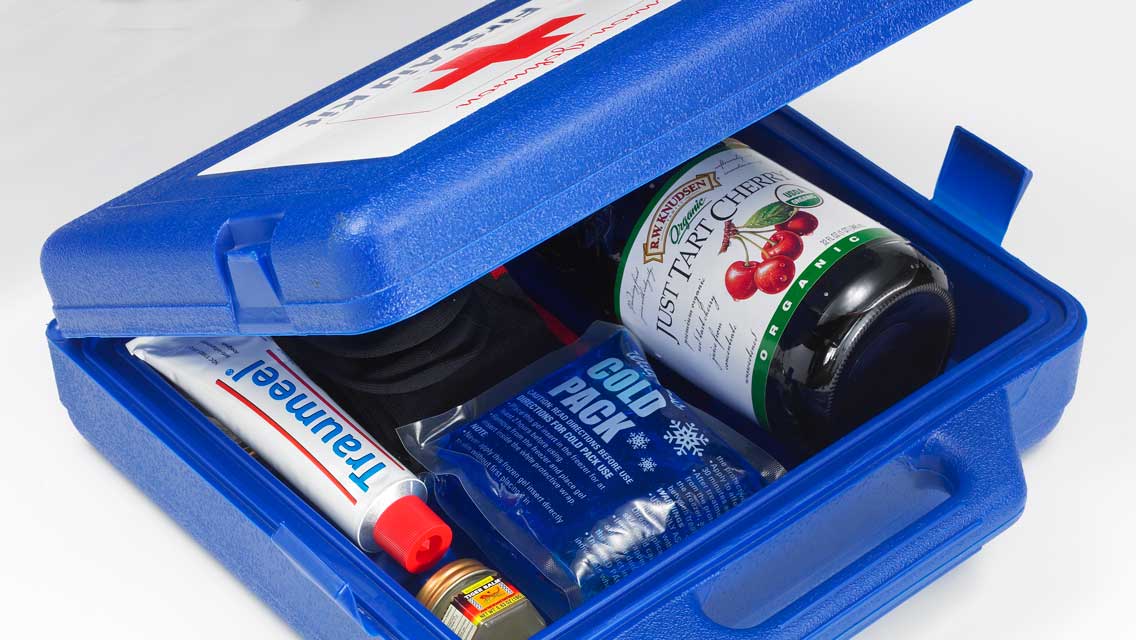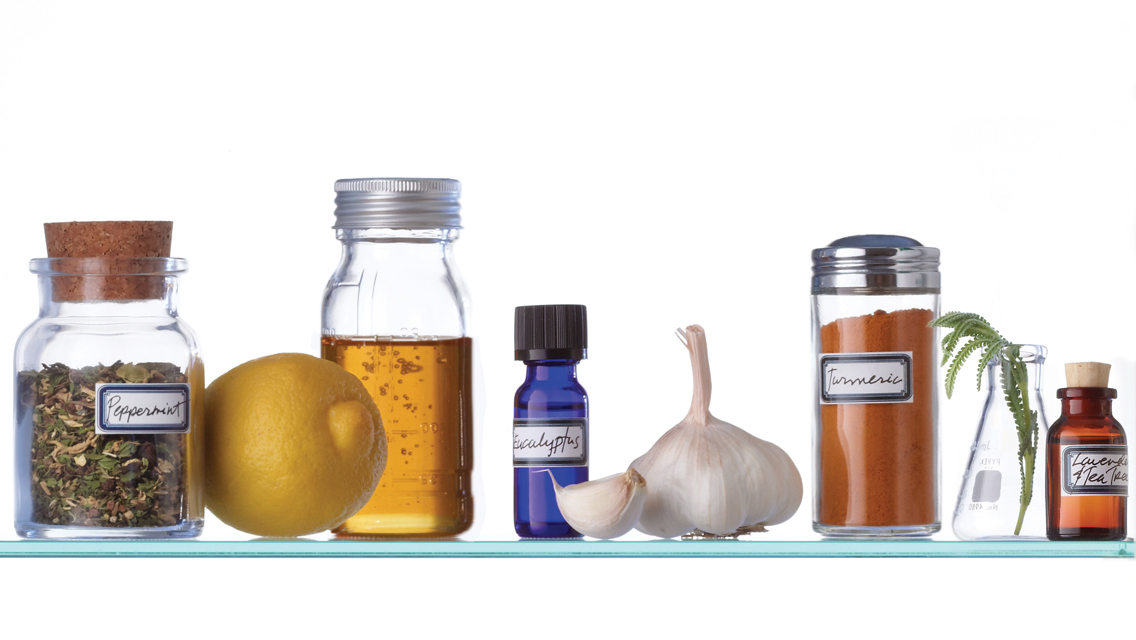It can be tough to rally for another bout of exercise when you’re still stiff and sore from your last all-out effort. There’s a reason you’re hurting: Exercise creates inflammation and swelling from microscopic tears in your musculoskeletal tissues. Add to that a biochemical buildup of muscle-borne acids and enzymes, and it’s no wonder we need a little recovery time.
But we need to start healing as soon as possible after our workouts, says Mark Klion, MD, orthopedic surgeon and medical codirector of the New York City Triathlon. “Recovery requires immediate attention to reduce the bleeding and injury from damaged cells,” Klion says.
So what can you do to minimize (or even prevent) those nagging aches so you can resume your routine faster?
To find out, we polled pro athletes and trainers, who shared their favorite all-natural recovery tools. Some are backed by science, while others are supported by overwhelming anecdotal evidence from the field and the gym. All are options to consider for your own recovery toolbox.
Arnica
Why: This European and Central Asian flower, first used in the 16th century to treat soreness, is dried and used in tinctures, homeopathic remedies, topical creams and capsules. It’s believed that natural flavonoids in the plant decrease permeability of the blood vessels, thus reducing bleeding and bruising. Polysaccharides in the plant stimulate the process by which helper cells clean the tissue of unwanted toxins and speed healing.
Says Who: Although widely studied and considered safe by the Western medical community, arnica’s benefits are also backed by years of anecdotal evidence. Several athletes we spoke with swear by Traumeel ointment, a homeopathic rub that includes arnica as its main active ingredient (along with other healing and soothing herbs such as echinacea and chamomile).
How-To: You’ll find arnica at just about any drugstore. Following the package instructions, apply the cream, gel, compress or tincture (arnica comes in many forms) where you feel any soreness. You can also use it immediately after a fall or collision to prevent bruising and swelling. Just don’t apply it to broken skin or open wounds.
Ice Therapy
Why: Ice is a strong vasoconstrictor, stopping blood vessels from bleeding in the event of an injury. “Soreness can be helped with local application of ice because it reduces inflammation,” says Klion.
Says Who: Doctors and professional athletes. “In multiday races, the key to success is quick recovery,” notes Adam Chase, ultramarathoner, adventure racer and coauthor of the The Ultimate Guide to Trail Running (Globe Pequot Press, 2010). “After each day’s stage, we’d soak in a very cold mountain stream, trying to keep our legs submerged for at least five minutes.”
How-To: Andrea Metcalf, CPT, Today show fitness contributor and celebrity trainer, advocates icing sore muscles as soon as possible postworkout. Soak (if you can stand it) in an ice bath for 15 minutes — just keep in mind that some experts recommend not submerging your heart. Or, apply an ice pack to the affected muscles for 15 to 20 minutes. Ice therapy is less effective the longer you wait, so put it toward the top of your postworkout to-do list.
(For a deeper dive into the benefits of cold therapy, see “The Health Benefits of Cold Conditioning“.)
Heat Rubs
Why: Heat gets the blood flowing in your muscles, ligaments and joints, which helps flush out toxins and speed recovery. Most rubs generate heat with ingredients like menthol, eucalyptus or cayenne pepper (which contains a chemical called capsaicin that is thought to flush toxins). A 2007 study published in the American Journal of Physiology found that applying menthol externally raises the core body temperature, just as applying physical heat would.
Says Who: Athletes and fitness pros. Native Americans have used cayenne rubs for centuries to promote blood flow and healing.
How-To: Although ice is most effective immediately following a workout or injury, heat applications can also help in the hours and days that follow. When the bleeding in the injured capillaries has stopped, heat helps the extra blood to be reabsorbed by the body. It also relieves constriction in the muscles and prevents further injury by helping to relax them. (Note: Heat rubs should never be used in place of a proper warm-up — see “The Art of the Warm-Up”.)
Tart Cherry Juice
Why: Tart cherries contain compounds called anthocyanins, which have been shown to reduce inflammation; they also have flavonoids, which improve blood flow to muscles and speed recovery.
Says Who: Declan Connolly, PhD, director of the Human Performance Laboratory at the University of Vermont, studied the effects of tart cherry juice on muscle recovery and published the results in the British Journal of Sports Medicine. His team of researchers found that cherry juice minimizes inflammation and significantly speeds up muscle recovery: “It’s very high in antioxidants and natural anti-inflammatories, and for those reasons it seems to work.” Other studies conducted at the University of California at Davis and Johns Hopkins Hospital support Connolly’s findings.
How-To: For the most benefit, Connolly recommends downing a glass or two of tart cherry juice the day before and the day of a big workout. One company, Cherrypharm (www.cherrypharm.com) offers a highly concentrated tart cherry sports drink, which Connolly recommends over powders or capsules.
Compression Garments
Why: Sore muscles are caused by microtears and bleeding, so the theory is compression acts like a tourniquet to slow the bleeding, Klion says. Some manufacturers of compression garments claim they keep your joints better aligned, improving performance and preventing injury, while
others focus on preventing postexercise soreness.
Says Who: Some researchers and professional athletes. Mike Decker, PhD, a biomechanist in Vail, Colo., has been studying the effects of compression tights with knee support for a garment company called Opedix. His research suggests that using tights that resist lateral motion of the lower leg and knee may prevent soreness and injury. But even if you don’t want to wear compression garments during exercise, says Klion, you can still use compression to speed your recovery afterward.
How-To: Compression garments are gaining popularity — both during and after exertion — because they’re easy to use (just wear the compression garments as you would any others). Make sure they fit snugly without being too constricting — you should feel like your legs are being gently squeezed, yet still have the freedom to move comfortably. An Ace bandage can do the trick in a pinch, says Klion. Wear it during exercise to mitigate soreness in a previously injured area or apply it immediately after your workout. “Just be careful not to cut off your circulation — that could cause more problems,” he advises.
Massage
Why: Kneading taxed muscles prevents further injury by increasing mobility and lubricating soft tissue, and may also speed muscle recovery by flushing away the toxic byproducts of exercise and increasing blood flow to the muscles. “Massage therapy helps to bring balance back to tight, shortened muscles after exercise,” says Joe Sweeney, a certified therapeutic massage and bodywork practitioner in Boulder, Colo. It helps realign muscle fibers and relieve tension in tendons, too.
Says Who: Experts debate whether massage actually clears toxins from your blood, but there’s no question that it’s beneficial, helping reduce the knots and muscle spasms that lead to soreness. Plus, it reduces stress. “Massage engages the parasympathetic nervous system, helping to promote recovery and repair,” says Jaymie Garner, massage therapist and owner of Smiling Lotus Massage in Los Angeles, Calif.
How-To: Get a gentle massage to increase circulation, but wait at least a few hours to a day to get deep-tissue massage, which can exacerbate microtears and microbleeding. No budget for a pro? Self-massage implements and foam rollers work fine.
Give It a Rest
We all know that sleep is important in proper recovery. But why? And how much sleep do you need? “Our bodies’ greatest production of human growth hormone, which rebuilds taxed muscles, occurs while we’re asleep,” explains Mark Klion, MD, an orthopedic surgeon, nine-time Ironman triathlete, and medical codirector of the New York City Triathlon. Ideally, you should aim for a full eight hours of sleep per night, especially while you’re training for an event. But if that’s not feasible, take naps whenever possible, say experts. Even 30 minutes of shuteye midday can lower stress hormones and support your recovery.
Nutrition and Recovery
Emphasizing alkalizing foods in your diet can improve your recovery.
Your body’s pH plays an important role in your recovery, says Christopher Vasey, ND, author of The Acid-Alkaline Diet for Optimum Health. A neutral or slightly alkaline pH can keep chronic inflammation at bay, leading to speedier recovery postworkout, while a more acidic profile is associated with early fatigue and leg cramps, which can take a toll on your exercise routine.
Include alkaline-forming foods (such as those listed below) in your postexercise meals to maintain a neutral pH. Eat such foods alone, or mix them in a salad or smoothie with some protein for the biggest recovery boost.
- Asparagus
- Apples
- Apricots
- Bananas
- Carrots
- Celery
- Cherries
- Collards
- Cucumber
- Green beans
- Kiwifruit
- Lemon juice
- Melon
- Onions
- Oranges
- Peaches
- Pears
- Pineapple
- Squash
- Strawberries
- Sweet potatoes
(To learn how to balance your body’s pH, check out the “pH Factor“.)
This article originally appeared as “The Fast Recovery Kit” in the April 2010 issue of Experience Life.




This Post Has 0 Comments